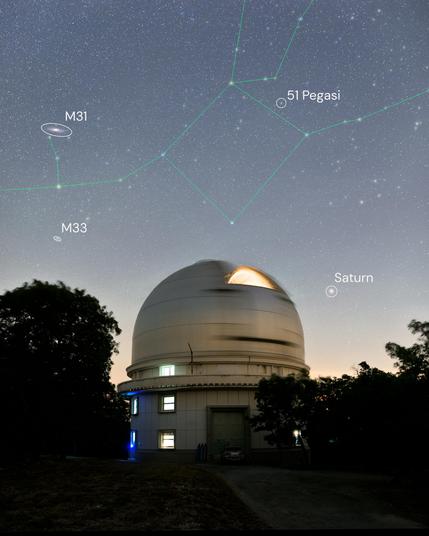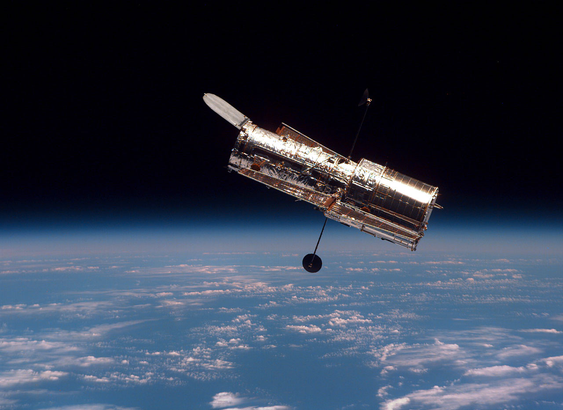ESA'dan Mars üzerinde sanal uçuş videosu! 🚀 Mars Express verileriyle hazırlanan bu büyüleyici görüntüler, Kızıl Gezegen'i hiç bu kadar detaylı görmediğinizi hissettirecek. Uzay keşiflerinde yeni bir pencere açılıyor!
#Esa
Live feed: https://www.youtube.com/watch?v=iYmvCUonukw
Current location: http://www.openstreetmap.org/?mlat=29.9866&mlon=-18.5321&zoom=2
ArianeGroup CEO Poached by French Train Maker - European Spaceflight
2025 October 10
50 Light-years to 51 Pegasi
* Image Credit & Copyright: José Rodrigues
https://joserodrigues.space/
Explanation:
It's only 50 light-years to 51 Pegasi. That star's position is indicated in this snapshot from August 2025, taken on a night with mostly brighter stars visible above the dome at Observatoire de Haute-Provence in France. Thirty years ago, in October of 1995, astronomers Michel Mayor and Didier Queloz announced a profound discovery made at the observatory. Using a precise spectrograph they had detected a planet orbiting 51 Peg, the first known exoplanet orbiting a sun-like star. Mayor and Queloz had used the spectrograph to measure changes in the star's radial velocity, a regular wobble caused by the gravitational tug of the orbiting planet. Designated 51 Pegasi b, the planet was determined to have a mass at least half of Jupiter's mass and an orbital period of 4.2 days. That made the exoplanet much closer to its parent star than Mercury is to the Sun. Their discovery was quickly confirmed and Mayor and Queloz were ultimately awarded the Nobel Prize in physics in 2019. Now recognized as the prototype for the class of exoplanets fondly known as hot Jupiters, 51 Pegasi b was formally named Dimidium, Latin for half, in 2015. Since its discovery 30 years ago, over 6,000 exoplanets have been found.
https://ui.adsabs.harvard.edu/abs/1995Natur.378..355M/abstract
https://www.planetary.org/articles/color-shifting-stars-the-radial-velocity-method
https://arxiv.org/abs/1801.06117
https://earthsky.org/space/this-date-in-science-first-planet-discovered-around-sunlike-star/
3D (INTERACTIVE):
https://eyes.nasa.gov/apps/exo/#/planet/51_Peg_b
https://apod.nasa.gov/apod/ap251010.html
#space #exoplanets #astrophotography #photography #science #astronomy #tech #NASA #ESA #education #apod
Live feed: https://www.youtube.com/watch?v=iYmvCUonukw
Current location: http://www.openstreetmap.org/?mlat=-1.7657&mlon=73.5889&zoom=2
I am grateful for the #Hubble Space Telescope
📷 :https://esahubble.org/images/s82e5937/
#Astronomy #AstroDon #Space #science #NASA #ESA #astrophotography
The Birth of Baby Planets: Witnessing Planetary Formation in Real-Time
Read More: https://astronex.net/the-birth-of-baby-planets-witnessing-planetary-formation-in-real-time/
#space #astrology #astronomy #NASA #science #solarsystem #astro #nature #mars #esa #spacex #planets #SpaceExploration
Lunar Base Plans: NASA’s 2025 Milestones
Read More: https://astronex.net/lunar-base-plans-nasas-2025-milestones/
#space #astrology #astronomy #NASA #science #solarsystem #astro #nature #mars #esa #spacex #planets #spaceexploration
Why Is Venus Hotter Than Mercury?
Read More: https://astronex.net/why-is-venus-hotter-than-mercury/
#space #astrology #astronomy #NASA #science #solarsystem #astro #nature #mars #esa #spacex #planets #spaceexploration
How Do Saturn’s Rings Stay Stable?
Read More:https://astronex.net/how-do-saturns-rings-stay-stable/
#space #astrology #astronomy #NASA #science #solarsystem #astro #nature #mars #esa #spacex #planets #spaceexploration
What If Pluto Was Earth’s Moon?
Read More: https://astronex.net/how-what-if-pluto-was-earths-moon/
#space #astrology #astronomy #NASA #science #solarsystem #astro #nature #mars #esa #spacex #planets #spaceexploration
How Does Uranus’ Tilt Affect Its Seasons?
Read More: https://astronex.net/how-does-uranus-tilt-affect-its-seasons/
#space #astrology #astronomy #NASA #science #solarsystem #astro #nature #mars #esa #spacex #planets #spaceexploration
What If Jupiter Became a Star?
Read More: https://astronex.net/what-if-jupiter-became-a-star/
#space #astrology #astronomy #NASA #science #solarsystem #astro #nature #mars #esa #spacex #planets #spaceexploration
Why Is Mars’ Core Cooling Faster?
Read More: https://astronex.net/why-is-mars-core-cooling-faster/
#space #astrology #astronomy #NASA #science #solarsystem #astro #nature #mars #esa #spacex #planets #SpaceExploration
Why Do Black Holes Spin So Fast?
Read More: https://astronex.net/why-do-black-holes-spin-so-fast/
#space #astrology #astronomy #NASA #science #solarsystem #astro #nature #mars #esa #spacex #planets #spaceexploration
Why is Saturn’s Ring System Disappearing?
Read More: https://astronex.net/why-is-saturns-ring-system-disappearing/
#space #astrology #astronomy #NASA #science #solarsystem #astro #nature #mars #esa #spacex #planets #spaceexploration
Why Do Some Moons Have Oceans?
Read More: https://astronex.net/why-do-some-moons-have-oceans/
#space #astrology #astronomy #NASA #science #solarsystem #astro #nature #mars #esa #spacex #planets #spaceexploration
Is Jupiter’s Great Red Spot About to Collapse?
Read More: https://astronex.net/is-jupiters-great-red-spot-about-to-collapse/
#space #astrology #astronomy #NASA #science #solarsystem #astro #nature #mars #esa #spacex #planets #spaceexploration


